StudioEIS Brings History to Life through Bronze
Tucked away on the water's edge of Brooklyn, NY, StudioEIS has been crafting amazingly realistic bronze works that have graced the halls of some of the most traversed buildings and outdoor spaces for more than 30 years. Whether is was the Ralph Kramden sculpture greeting you at Port Authority or the series of historical figures at Philadelphia's Constitution Center, chances are you've walked right past StudioEIS's bronze works once or twice, and most likely gave a double take at the sharp realism that has become the studio's trademark.
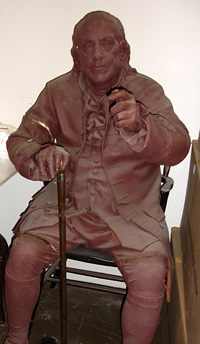 Clay casting of Benjamin Franklin at StudioEIS's Brooklyn studio
Clay casting of Benjamin Franklin at StudioEIS's Brooklyn studioPhotograph by Paul David
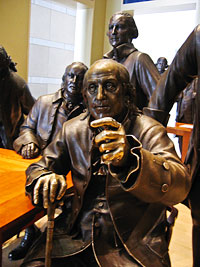 Bronze series at Philadelphia's Constitution Center by StudioEIS
Bronze series at Philadelphia's Constitution Center by StudioEISPhotograph by Andrew Loder
Founded in 1976 by brothers Ivan and Elliot Schwartz, and later joined by their sister, Debra Schwartz, StudioEIS has grown to become one of the nation's leading 3D design and fabrication studios. The inspiration for founding the studio stems from the Schwartz's desire to help connect the artist to the public, bringing the art to life.
"Necessity, it can safely be said is the mother of all invention," remarks Ivan Schwartz of his original motivation to form StudioEIS. "While I had a classical training as a sculptor it was obvious that trying to create 'art' of a classical nature was going to be a dead end. Therefore, I had to find a niche where the talents and vision might be appreciated and indeed be supported financially, and clearly this was the world of museums, where every conceivable subject addressed by those institutions required someone to interpret their stories whether they were historical, anthropological or even of a sporting nature."
Today, the company utilizes 15,000 sq. foot of production space in Brooklyn, NY, ahead of the curve among this thriving arts scene on the fringe of Manhattan.
"Brooklyn was the place to come 23 years ago," recall Schwartz. "It was nearly a failed city within the great city and therefore interested in the likes of us - they offered us a cheap rent to boot."
Artists, sculptors, mold makers and other visual story tellers come together to produce 3D projects for museums, architects, interior and restaurant designers, corporations, retail and the entertainment world.
"Most of the artists are local, which is to say most of them live here now but have come from different parts of the world to be in a city like NY," says Schwartz. "Some of our artists do travel to become involved in specific projects- mostly from England or Ecuador."
Together, this dynamic team has been the leading force in the design and production of museum figures worldwide.
Studio EIS's impressive bronze and copper statues have immortalized numerous people of all walks of life, from past to present, and their ability to grasp the most minute detail is unprecedented.
 Head sculptor Jiwoong Cheh attaches head to sculpture commemorating Lincoln's 200th birthday celebration
Head sculptor Jiwoong Cheh attaches head to sculpture commemorating Lincoln's 200th birthday celebrationPhotograph courtesy of StudioEIS
They have worked with many corporate clients like Sony, American Airlines, Coca Cola, the Discovery Channel, and countless others, along with an impressive list of historical museums, including the Anchorage Historical & Fine Arts Museum, the Smithsonian Institution, Hong Kong History Museum, the National Museum of the American Indian and more. They have also worked on the Presidential Libraries of Franklin D. Roosevelt, Richard Nixon, Lyndon B. Johnson, Truman and others.
StudioEIS is also well-known for their popular TV Landmarks bronze series, commemorating Elvis in Hawaii, Andy Griffith and the Opie House in Los Angeles, CA, and Ralph Kramden at New York City's Port Authority Bus Terminal.
Most recently, the studio was asked to create a bronze work to commemorate Abraham's Lincoln's birthday.
"At the present time we're unveiling one of our most important works, Abraham Lincoln, for the Lincoln Cottage to celebrate his 200th birthday on February 12," reveals Ivan Schwartz. "We were commissioned by the National Trust for Historic Preservation. The cottage is approximately three miles from the White House, and it's believed that it was the site where he wrote the first draft of the Emancipation Proclamation. It was also suggested that President Lincoln enjoy some fresh air away from the Civil War for a respite and he rode his horse there. He had a bodyguard and a regimental guard, which isn't like our Secret Service of today, but he was shot at on several occasions during this ride as Washington DC was on the edge of the battle line. It has been noted that Lincoln was seen by Walt Whitman, the world's greatest poet, on his way out of town. We came up with the concept of Lincoln with his horse because during the days of 1862 through 1864 he spent summers riding back and forth between the White House and what is, today, downtown Washington."
Other upcoming projects include a sculpture of James and Dolley Madison for Montpelier, Orange, Virginia, in the foothills of the Blue Ridge Mountains at what was the lifelong home of James.
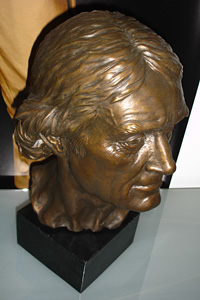 This bronze, the first of its kind depicting President Thomas Jefferson in his later years, will be unveiled this February.
This bronze, the first of its kind depicting President Thomas Jefferson in his later years, will be unveiled this February.Photograph by Paul David
"This is a full-body portrait of James and Dolley Madison that (at the present time) is still in clay and will go to the foundry," continues Schwartz. "The Montpelier home was owned in the 20th century by the duPont family who added many additions. The house has now been restored back to its original form when Madison resided there. I do the historical fact checking and I work with the curatorial staff."
Schwartz, and all of the StudioEIS team, put their heart and soul into every sculpture.
"The number of artists we use for any project varies and much happens simultaneously which means people work on numerous projects, says Schwartz. "Typically sculpting a portrait figure that becomes bronze will involve 3-4 people before it goes to mold and the foundry for casting where many more craftspeople become involved in the process."
The process not only involves sculpting but casting - using an original time honored process, which is then cast at Polich-Tallix in Newburg, NY.
At the end of the bronze production process specialists work with StudioEIS to create the patina with heat and acid that transforms the work. Installations are done with qualified installers and engineers to produce a comprehensive plan that makes the installation of bronze sculptures simple and professionally executed.
Extensive research and historical documentation is a vital proponent to StudioEIS's ability to capturing the essence of their bronze subjects.
"When we did the Lincoln Sculpture I visited the National Museum of American History and personally measured Lincoln's top hat and coat," says Schwartz. "Lincoln was 6'4" so in addition to the Ford's Theater, where he was shot, the staff also supplied historical information that helped us create the sculpture. When we were at Monticello we measured Jefferson's clothing, so these are the most accurate renditions of Lincoln, James and Dolley Madison, as well as Thomas Jefferson. We did Jefferson at the age of 68 (which would have been in 1809) after leaving the White House. We are doing it now because they are opening a new education wing and expanding their facilities so having a new image of Jefferson - especially at this age - is important. It fills in a gap. He had been painted many times before, but in retirement the painters and sculptors didn't turn up too much, therefore this is very realistic of Jefferson in an older age."
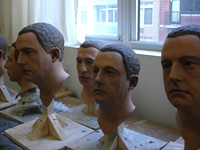 Molds depicting StudioEIS's trademark realism
Molds depicting StudioEIS's trademark realism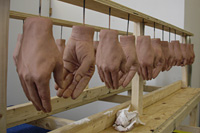 Hand molds ready for the next process
Hand molds ready for the next processPhotographs by Paul David
"At the National Constitution Center in Philadelphia we created and installed two presidents - James Madison and George Washington, as well as the signers of the US Constitution," Schwartz continues. "We did 42 sculptures but only two were presidents. I would say that the entire project is, of its type, perhaps, the largest in Americana history. The project began in early 2001 and was completed in May 2003. At the actual signing in September 1787, 42 people were in the room. In actuality, 39 men signed the constitution but three did not. However, we created all 42. It took approximately two years to complete and install it and its impact is amazing."
The 42 life-like statues were cast in bronze and numerous historical sources were called upon for accurateness, which is what StudioEIS uses to denote unlimited prospective. After a historian gathered all known physical descriptions and portraits of the delegates - including weight, height and body type - actors posed in period clothing to reconstruct the moment when the delegates assembled to sign the Constitution. Full body casts of each costumed actor were then created for the poses in the room. After that, the artists sculpted a detailed clay bust of each delegate's head, applied wax to the clay surface, allowed it to harden, and then applied another layer of clay for a mold. Using the 'lost wax process' the wax melted away and molten bronze was poured in its place. The artists then assembled bodies and heads onto a support, called an armature, and finished the joints by hand. They were then polished giving the bronze the amazing patina that can be seen in the "signer's room" (at the National Constitution Center).
In person at the National Constitution Center, the impact of the 42 sculptures in one room is enormous. Copper shadows of some of the men peek out of this amazing room luring visitors in, and once in the room, visitors view a collection with sharp realism and focus on details, eloquently captured by StudioEIS. Besides the fact that visitors can sign in and be part of the "We the People" story, the copper and bronze collection is visually breathtaking, and within the maze of statues one can interact because of their lifelike features and gestures that appear to make the visitor feel that they're part of the scene and in motion.
Each sculpture is perfect from head to toe - shiny copper ribbons tying their hair back, shirt ruffles, facial features, poses, seams, buttons and button holes plus folds in their clothing. Socks and shoe buckles and details that make you feel as if you were right there on September 17 (1787). The many months of research done by StudioEIS were apparent. The average height of each statue is 5'8", with the shortest delegate at 5'4". To help create the vision of each statue, portraits, etchings and drawings of the men were used except for one - Jacob Bloom of Delaware for whom no pictorial representation exists.
"While walking around this room I look around and occasionally have the illusion that one of the visitors is looking at me, but it's one of the statues," says Bill Del Governatore, of Philadelphia. "That's how lifelike they are!"
Resources:
Also in this Issue:
- StudioEIS Brings History to Life through Bronze
- Fountains by Design
- Mike Dumas Copper Designs: Where Old World Meets Southwest
- Stickley's Copper Arts & Crafts: History Hewn and Hammered
- 19th Annual Celebration of Fine Art in Scottsdale
